|
|
Brief
information on
|
|
Nikon / Nippon Kogaku Japan Ultra-Micro-NIKKOR
1:1.2 f=29.5mm, 30mm f/1.2, 50mm f/1.8, 55mm f/2 lenses
|
Nippon Kogaku Japan Ultra-Micro-NIKKOR 1:1.2 f=29.5mm e-line; Ultra-Micro-NIKKOR 1:1.2 f=30mm e-line, h-line
Year introduced: - 1964 29.5mm, 1969, 30mm; Discontinued: no info
Nippon Kogaku KK, Japan Ultra-Micro-NIKKOR
1:2 f=29.5mm (29.5mm f/1.2) was developed by Nikon in 1964, it can actually be treated
as the same as the 30mm /f1.2 introduced in 1969 because in quite a number of Nikon
Sales Manual actually used 30mm f/1.2 even if the actual focal length was quoted
as 29.5mm. Anyway, to be more appropriate, you can treat the 29.5mm /f1.2 as 30mm
f/1.2 Type 1 or Mk I if you like to differentiate the two. The lens offers ultra-high
resolution which reaches the maximum theoretical limit* of 1,250 lines/mm throughout
its entire 2mm diamter image area. * This probably was apply to during that period
as other selective UMN introduced at later stage possesed even higher resolving power
to reach 1,650 lines/mm later. Anyway, at the time of its introduction the design
and manufaturing standards had set a new milestone and had won high acclaim thoughout
the world.
 |
If you purely relate to the focal length of 29.5mm/30mm
to possible dimension of the Ultra-Micro-NIKKOR 1:2 f=29.5mm, you will be damn surprise
how it looks like. It wasn't pin-szied like the MACRO-NIKKOR, instead the entire
lens setup was more like a huge telephoto lens with a picture angle of merely 3.8° -well, at least this particular area
has all the element like a telephoto, huh ?
Focal Length: 29.5mm/30mm
maximum Aperture: f/1.2
Lens Construction: 9 elements in 6 groups
Standard Magnification: 1/25X
Picture Angle: 3.8°
Overall working distance: 810mm
Object area:- 50mm
image area:- 2mm
Standard wavelength: 546nm(e-line)
Aperture efficiency at image corner: 100% @ f/1.2 with 0% vignetting score
Distortion: -1.3%
Aerial resolving power: 1,250 lines/mm e-line model, 1,600 lines h-line
model
Aperture scale: f/1.2, f/1.4, f/2, f/2.8, f/4, f/5.6, f/8
Lens Mount: Screw d=50mm p=0.75mm
Dimension (D) X (L):- 60mm x 230mm
Filter thread size: 40.5mm screw-in type
Weight:- 800g/1.76Ibs
<<<--- Unlike
normal Nikkor lenses being arranged in group where the tallest lenses are usually
the super telephotos or super-zoom; this photo shown the tallest two lenses are actually
the UMN 29.5mm/30mm f/1.2 with almost the shortest focal length in the Ultra-Micro-NIKKOR lens family.
|
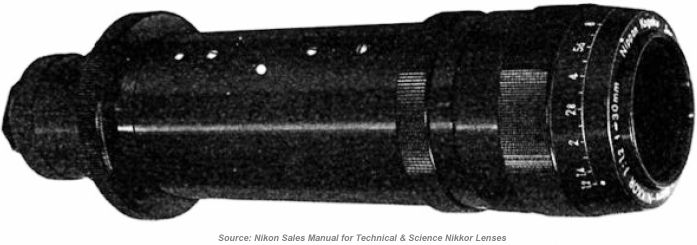 |
<<<--- Not
a very good picture source of this Ultra-Micro-NIKKOR 1;1.2 f=30mm but at least you
cna take a good look of how it looks like in side view.
Request: Anyone has better
info or pictures of these related optics ? Please mail my buddy: rick-oleson@yahoo.com
|
 |
NOTE:-
The specification usually mentioned the accessory filter thread size, mostly in 40.5mm
or 50.3mm nad/or 62mm/72mm. The Ultra-Micro-NIKKOR also uses filters. These special
filters have been specifically designed to develop the performance of UMN lenses
to fullest extent.
|
They actually consist of two separate filter glasses, each with differing wavelength
transmission factors, but bonded together and responsive to the wavelengths of the
photo-sentitizer. In addition, they are light-discriminatory, transmitting only the
e-line. The planes feature perfect flatness and parallelism and will detract in no
way from the ultimate excellent resolving power of any Ultra-Micro-NIKKOR lens to
which they are attached. A general guide to e-line filters, filter sizes the
relative UMN lenses:-
|
attachment size
|
applicable lens
|
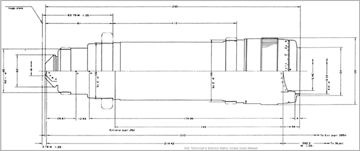
|
|
40.5mm
|
UMN 28mm f/1.8; 29.5/30mm f/1.2, 55mm
f/2
|
|
62mm
|
UMN 135mm f/4
|
|
72mm
|
UMN 125mm f/2.8, 155mm f/4
|
| |
|
|
| |
Nippon Kogaku Japan Ultra-Micro-NIKKOR 1:1.8e f=50mm & Ultra-Micro-NIKKOR
1:1.8h f=50mm Year introduced:
1969, Discontinued: No info
The Ultra-Micro-NIKKOR 1:1.8 f=50mm e-line
was believed an upgrade from the UMN f/2 @55mm focal length and developed for photorepeaters.
The image size has been increased from 12mm as found in the UMN 55mm 1:2 to 14mm
in diameter, thus even at the reduction of 1/5X and it was still capable of covering
the picture plance of a 10mm square. In addition, with its 600 lines/mm resolving
power within the 12mm in diameter, it would deliver a higher quality performance
exceeding the predeccessor, Ultra-Micro-NIKKOR 1:2 f=55mm e-line model.
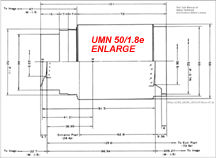 |
The h-line Ultra-Micro-NIKKOR 1:1.8 f=50mm even can deliver
higher resolving power where 650 lines/mm for 14mm image circle and/or 10mm square
diameter or 800 lines/mm in smaller 10mm image circle. The image size are depends
on actual usage of imprinting. Both lenses has a very different appearance from the
previous model, looks more modern with a sleek design, cased within an aluminium
lens barrel but external has a black rotary lens tube, so only the front section
of the lens was shown with aluminium while the UMN 55/2 was the other way round.
But optical construction of both lenses share similar, a rather complex 12 elements
in 9 groups design for a "50mm" lens.
<<<--- Dimensions, measurement of UMN 50/1.8e
|
|
| |
|
Technical Specifications for Nippon Kogaku Japan, Micro-Nikkor-NIKKOR 1:1.8 f=50mm
e-line,
h-line
| Ultra-Micro-NIKKOR 1:1.8 f=50mm e-line type |
Ultra-Micro-NIKKOR 1:1.8 f=50mm h-line type |
Focal Length: 49.2mm
maximum Aperture: f/1.8; Minimum Aperture: f/1.8 FIXED
Lens Construction: 12 elements in 9 groups
Standard Magnification: 1/5 X
Picture Angle: 13.1°
Overall working distance: 315mm
Object area:- 70mm
image area:- 14mm
Standard wavelength: 546.1 milli-micron (e-line);
Aperture efficiency at image corner: 100% @ f/1.8 with 0% vignetting score
Distortion: -0.004%
Aerial resolving power:
500 lines/mm - 14mm image circle;
600 lines/mm - 12mm image circle
Aperture scale: f/1.8
Lens Mount: Screw d=52mm p=1mm
Dimension (D) X (L):- 58mm x 101mm
Filter thread size: 52mm screw-in type
Weight:- 642g |
Focal Length: 49.2mm
maximum Aperture: f/1.8; Minimum Aperture: f/1.8 FIXED
Lens Construction: 12 elements in 9 groups
Standard Magnification: 1/5 X
Picture Angle: 7.6°
Overall working distance: 315mm
Object area:- 70mm
image area:- 14mm
Standard wavelength:
435 milli-micron (g-line); 404 milli-micron (h-line)
Aperture efficiency at image corner: 100% @ f/1.8 with 0% vignetting score
Distortion: -0.002%
Aerial resolving power:
650 lines/mm - 14mm image circle;
800 lines/mm - 10mm image circle
Aperture scale: f/1.8
Lens Mount: Screw d=39mm p=1/26"
Dimension (D) X (L):- 51mm x 70mm
Filter thread size: 40.5mm screw-in type
Weight:- 700g |
|
|
Nippon Kogaku Japan Ultra-Micro-NIKKOR 1:2 f=55mm e-line & Ultra-Micro-NIKKOR 1:2 f=55mm h-line
Year introduced: 1965, Discontinued: No info
The Ultra-Micro-NIKKOR 1:2 f=55mm
was the first lens offered between the 50~55mm focal length. Introduced in 1965,
and it was designed for making photomasks under step & repeat method in manufacturing
of IC and LSI for semiconductor companies. It offered production printing on a wide
plance of 12mm in diameter with a magnification of 1/4X. The lens mount and working
distance for this lens was actually similar with the Ultra-Micro-NIKKOR 1:1.8 f=28mm
series. The standard wavelength is 546 milli-micro (e-line) with resolving power
delivering 500 lines/mm on an image circle of 12mm. The lens has a chrome on brass
lens barrel with front to mid section in black paint. Within, the lens construction
consists of a 8 elements in 6 groups optical design.
 |
The subsequent Ultra-Micro-NIKKOR 1:2
f=55mm h-line model shares most of the basic lens features with the e-line model,
except for picture angle was narrower @ 8.2° as compared to 9.8° on the e-line
model and relates to object/image area differs from 48mm/12mm to 40mm/10mm on the
h-line model; it has a higher resoluton at 650 lines/mm @ 10mm image circle and standard
wavelngth at 404.7 milli-micro h-line and 435 milli-micron on g-line. This model
shares similar 39mm screw lens mount.
<<<--- A
rough picture showing the difference in form and design from 1965's 55mm f/2 to the
1969's 50mm f/1.8 model. Note:
comparison among the few are not to scale.
Request: Anyone has better info or pictures of
these related optics ? Please mail my buddy: rick-oleson@yahoo.com
|
| |
|
| Ultra-Micro-NIKKOR 1:2 f=55mm e-line type |
Ultra-Micro-NIKKOR 1:2 f=55mm h-line type |
Focal Length: 55.8mm
maximum Aperture: f/2
Lens Construction: 8 elements in 6 groups
Standard Magnification: 1/4X
Picture Angle: 9.8°
Overall working distance: 315mm
Object area:- 48mm
image area:- 12mm
Standard wavelength: 546.1 milli-micron (e-line);
Aperture efficiency at image corner: 100% @ f/2 with 0% vignetting score
Distortion: -0.00%
Aerial resolving power: 500 lines/mm - 12mm image circle;
Aperture scale: f/2, f/2.8, f/4, f/5.6, f/8
Lens Mount: Screw d=39mm p=1/26"
Dimension (D) X (L):- 51mm x 65mm
Filter thread size: 40.5mm screw-in type
Weight:- 325g/11.5oz |
Focal Length: 55.8mm
maximum Aperture: f/2
Lens Construction: 8 elements in 6 groups
Standard Magnification: 1/4X
Picture Angle: 8.2°
Overall working distance: 315mm
Object area:- 40mm
image area:- 10mm
Standard wavelength:
404.7 milli-micron (h-line); 435 milli-micron (g-line);
Aperture efficiency at image corner: 100% @ f/2 with 0% vignetting score
Distortion: -0.01%
Aerial resolving power: 650 lines/mm - 10mm image circle;
Aperture scale: f/2, f/2.8, f/4, f/5.6, f/8
Lens Mount: Screw d=39mm p=1/26"
Dimension (D) X (L):- 51mm x 65mm
Filter thread size: 40.5mm screw-in type
Weight:- 325g/11.5oz |
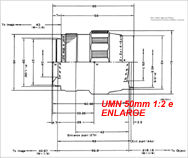 |
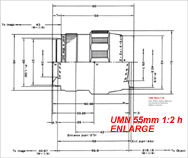 |
| |
| NEXT | 4/7 Nippon Kogaku K.K. Ultra-Micro-Nikkor
Series @ 105,
125 & 135mm focal length
IIndex
Page: Nippon
Kogaku K.K. S-Mount rangefinder version Micro-NIKKOR.C 1:3.5 f=5cm (50mm f/3.5)
Page 1:- Micro-NIKKOR
70mm f/5 / Micro-NIKKOR 150mm/5.6 / Macro-NIKKOR Series
:- 19/2.8, 35mm f/4.5, 65mm/4.5, 120mm f/6.3
Page 2:- Ultra-Micro-NIKKOR
Series -28mm focal length models
Page 3:- Ultra-Micro-NIKKOR
Series - 29.5/30mm, 50 & 55mm focal length models
Page 4:- Ultra-Micro-NIKKOR
Series - 105, 125, 135mm & 150mm focal length models
Page 5:- Ultra-Micro-NIKKOR
Series - 155, 165, 225, 250 & 300mm focal length models
Page 6:- General
information on other special purpose NIKKOR lenses
for industrial. technical and science applications
Nikon RF-Nikkor lenses:- Main Index Page
W-Nikkor-O 1:4 f=2.1cm | W-Nikkor.C 1:4 f=2.5cm | W-Nikkor.C
1:3.5 f= 2.8cm | W-Nikkor.C 3.5cm lens Group (3.5/2.5/1.8) | Stereo-Nikkor 1:3.5 f=3.5cm | 5cm (50mm) lens group | RF Micro-Nikkor 1:3.5 f=5cm (in progress) | Nikkor-P.C 1:2 f=8.5cm lens group / Nikkor-S.C 1:1.5 f=8.5cm lens group | Nikkor-P.C 1:2.5 f=10.5cm
lens group / Nikkor-T 1:4 f=10.5cm | Nikkor-Q.C 13.5cm lens group: 135/4, 135/3.5 Early
/ Last Version, 135/4 Bellow lens
| Nikkor-H 1:2.5
f=18cm | Nikkor-Q 1:4 f=25cm
| Nikkor-T 1:4.5 f=35cm | Nikkor-T.C 1:5 f=50cm | Reflex-Nikkor 100cm f/6.3
System Accessories
for Nikon Rangefinder cameras
Optical Finders (4 parts):- Fixed Focal length Finders (index page): 2.1cm,
2.5cm, 2.8cm,
3.5cm, 35cm Stereo,
5cm, 8.5cm, 10.5cm,
13.5cm | Variframe / Varifocal / Sport-frames
| Nikon Reflex Housing
Nikon
S36/S72/S250 Motor Drives
/ S36 Manual |
light meters | Nikon RF Flash/Speedlights | Close-up
photography / Repro Copy Outfit / Nikon Bellow Focusing Device (in progress) | Cases/Compartments | Lens & body caps,
Lens Hoods/shades,
Original Price Lists |
packaging/boxes
Instruction
Manuals
RELATIVE:- Nikon Rangefinder (RF) Models | Pictorial History of Nikon
A small visual library on
Nikon Ultra-Micro-Nikkor lenses
Manual Focus Nikkor lenses | Autofocus
Nikkor lenses
Related info:- Leica/Leitz
| Contax/Carl
Zeiss | Seiki Kogaku
(Canon)
| Message Board | lenses | Message Board | RF cameras
Nikon
Auto
Focus
Nikkor lenses:- Main Index Page
Nikon Manual
Focus
Nikkor lenses:- Main Index Page
| Back | Main
Index Page of Pictorial History of Nikon SLRs
about this photographic web site
 |
Home - Photography in Malaysia
|

Credit:- Special thanks to all the contributors of images
and content which made up the basis of the site. Note:certain content and
images appeared in this site were either scanned from official marketing leaflets,
brochures, sales manuals or publications published by Nikon over the years and/or
contribution from surfers who claimed originality of their work for educational purposes.
The creator of the site will not be responsible for may discrepancies arise from
such dispute except rectifying them after verification."Nikon",
"Nikkormat", "Nippon Kokagu KK" & "Nikkor"
are registered trade name of Nikon Corporation Inc., Japan. Site made with an Apple
G5 IMac.
|